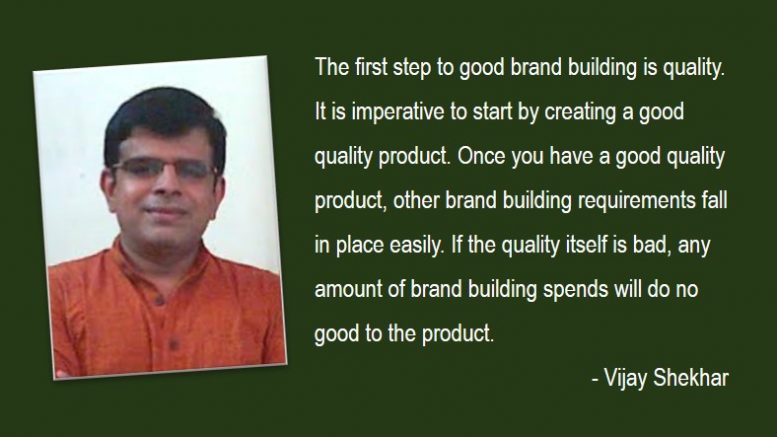Believe it or not, but my first lesson on the importance of brand building came from a roadside beggar.
This was during my B. Com. days in Pune around 1994 – 1997. Joshi vada pav was a newfound craze back then. They used to have only one small outlet. Am told that today they have around 20 – 25 outlets across the length and breadth of the city.
Their vada pav used to be famous across the city then, and their journey towards becoming a ‘brand’ would have started just around that time. The place used to be crowded at any earthly hour of the day…so much so that if someone wanted to have two vada pavs, s/he would be given only one first and asked to wait for the second one, so that everyone who was waiting could be fairly served.
Just next to this outlet was another vada pav outlet called Sapna (name changed) Vadewale…they made equally good vada pavs, but were yet to become a ‘name’ like Joshi. Sapna had very few customers when compared to Joshi…many of them being those who were in a hurry and couldn’t afford to wait long at Joshi.
Around that time, a vada pav used to be generally priced at Rs. 2/-… Sapna’s price was Rs. 3/-, and Joshi’s Rs. 4/-. I became a regular at both Joshi and Sapna…would generally prefer Joshi because they had a ‘name’; but many a time would go to Sapna…to avoid the wait time at Joshi; or if I just wanted to save a rupee. In terms of taste, both did not disappoint me.
Just outside their outlets, they had placed dustbins for customers to throw away the remains…leftover chutney and green chillies, and the newspaper piece on which the vada pavs were served. Joshi’s dustbin used to overflow with remains most of the time, and had to be emptied every now and then. Sapna’s dustbin on the other hand took its own time to fill up. Any Joshi customer who threw the remains into Sapna’s dustbin (on account of Joshi’s dustbin being full) would be subject to a ridiculing look from the middle-aged man standing at the Sapna counter…am not sure if he was the owner or one of the staff. But he used to make Sapna’s unwritten rule of ‘only MY food remains go into MY dustbin’ very clear with his angry look.
One evening when I was waiting for my vada pav at Joshi, I saw a roadside beggar hovering around the place. He asked for money from a few people…they didn’t give, either because they didn’t want to lose focus on the vada pav that they were eating or anticipating; or because they simply didn’t want to give. The beggar then started picking up from the remains in the dustbin, and even put a couple of morsels into his mouth. It was an uneasy sight for everyone around. A kind-hearted man forbade him from doing so. The man (who was waiting for his Joshi vada pav) took out Rs. 3/- from his wallet and gave it to the beggar, while pointing out to the Sapna outlet…he assumed that the ‘lesser vada pav’ should be fine for a roadside beggar.
The beggar happily accepted Rs. 3/-, took out Re. 1/- from his tatters, and headed straight to Joshi’s counter. Seeing this, the kind-hearted man and everyone else including me, had that ‘Wah…kya baat hai’ expression on our faces. And that’s when I learnt the importance of good brand building, and how it impacts every class of society.
I have seen and have also been part of quite a few brand building campaigns ever since. But ‘Joshi vs Sapna’ continues to remain my first impactful case study on the topic.
So what did Joshi Vadewale do right in terms of brand building?
There is no single formula for good brand building. It’s a mix of innovation, creativity, correct value proposition, constant monitoring and ensuring good customer experience…and above all maintaining GOOD QUALITY. It’s interesting to note here that ‘brand building’ was not a conscious effort during Joshi’s earlier days … it just happened. But why did it happen?
The answer lies in their good quality product. The first step to good brand building is QUALITY … it’s imperative to create and have a quality product. Once you have a good quality product, other brand building requirements start falling in place easily. If the quality itself is bad, any amount of brand building spend will do no good to the product. Joshi’s initial focus was only ‘good quality vada pav’. And they were focussed only on vada pav back then. Sapna on the other hand also had batata (potato) bhaji, kanda (onion) bhaji, bhaji pav (both potato and onion) and misal pav on their menu, pretty much like the other players in the space. The complete focus on that ‘one good product’ was missing. And this is what led to Joshi Vadewale subsequently becoming “Punyacha McDonald’s” (Pune’s McDonald’s) that it is today.
The views expressed here are that of the author and do not necessarily reflect that of Reputation Today.



Be the first to comment on "My first lesson in Brand Building"